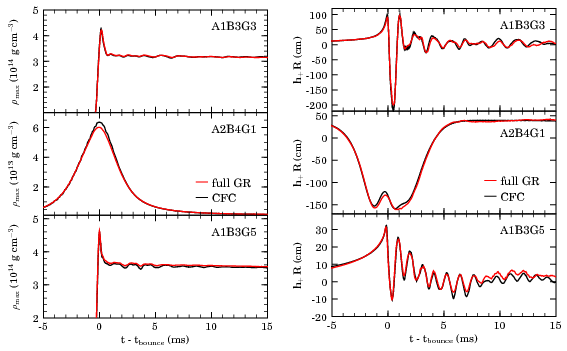| MPA-HOMEPAGE |
|
 |
Comparing Full General Relativity with the Conformally Flat Approximation in Rotating Supernova Core Collapse | ||
|
|
 Go to:
|
C.D. Ott ( H. Dimmelmeier (  Introduction:
Introduction:
The task of numerical relativity is to find numerical solutions of the Einstein equations, which are the equations governing the influence of gravity on an astrophysical system like ordinary stars, galaxies, neutron stars, black holes, or the entire universe. On the one hand, these equations are mathematically very complex, but additionally their numerical solution is also often hampered by instability problems. Therefore, in the past decades several approximation schemes have been introduced to both reduce the complexity of the Einstein equations and to circumvent the problems related to numerical instabilities.
One such approximative approach is the so-called conformal flatness
condition (CFC) or Isenberg-Wilson-Mathews approximation
[Wilson, et al., 1996], which
we have utilized in numerical simulations of general relativistic
rotating core collapse with a
In CFC the Einstein equations are simplified by assuming conformal flatness for the three-metric gammai j: gammai jCFC = phi 4 gammai jflat, where phi is the conformal factor and gammai jflat is the flat three-metric. Apart from reducing the complexity of the hydrodynamic and metric equations, this approach also exhibits numerical stability even for long evolution times, as it solves all constraint equations and thus cannot violate them by definition. 
The up-to-now most successful formulation of the exact Einstein equations for numerical relativity is the Baumgarte-Shapiro-Shibata-Nakamura (BSSN) formulation, also known as Nakamura-Oohara-Kojima (NOK) formalism. This way of reformulating the Einstein equations has been known for several years, but only recently new developments for gauge conditions paved the way for its application to simulations of rotating supernova core collapse.
In order to quantitatively estimate how accurate the CFC
approximation is compared to other approximation schemes
or to solving the exact Einstein
equations (e.g. by using the BSSN formulation), several
attempts have been made. An early study
[Shibata and Sekiguchi, 2004], which was
limited to only a few models of rotating supernova
core collapse, has demonstrated that the results using either CFC or
BSSN agree rather well in this astrophysical scenario. A different
approach was undertaken by comparing the CFC approximation to an To unambiguously establish the excellent performance of the CFC approximation, we have now made a direct comparison of two codes with different grid setups, coordinate choices, gauge conditions, and mesh refinement prescriptions, with one of the codes using the CFC approxiations for gravity (CoCoNuT), and the other one utilizing the BSSN scheme (Cactus-Whisky) [Ott, et al., 2006a, Ott, et al., 2006b, Ott, et al., 2006c].
The astrophysical models we choose are collapsing stellar cores
in a supernova, which lead to the formation of a rotating
proto-neutron star. For the description of the matter we have either
used a simple 
When comparing results from the fully general relativistic BSSN and approximate CFC collapse calculations, we find no significant deviations that could be attributed to systematic deficiencies of the CFC approximation. Both quantities relevant for the dynamic evolution of the collapsing core and the gravitational radiation waveforms agree very well in both approaches. This study is the by far most advanced and general demonstration of the how well CFC actually approximates the fully general relativistic Einstein equations. Additionally, by means of the Cotton-York tensor, Y i j = epsiloni l m nablal (Rmj - 1/4 deltamj R) (which is zero in a situation where the spacetime is conformally flat, i.e. if CFC is an exact representation of the Einstein equations), we are able to quantitatively analyze the deviation of CFC from BSSN. Indeed we find that the (density-weighted volume integral of the) Cotton-York tensor is always below 2% during the entire collapse, even for rapidly rotating models.
|